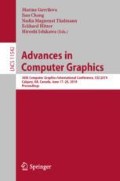Abstract
This paper presents a multi-level approach to simulate large crowds [18] called BioClouds. The goal of this work is to model larger groups of agents by simulating aggregation of agents as singular units. This approach combines microscopic and macroscopic simulation strategies, where each group of agents (called cloud) keeps the global characteristics of the crowd unity without simulating individuals. In addition to macroscopic strategy, BioClouds allows to alter from global to local behavior (individuals), providing more accurate simulation in terms of agents velocities and densities. We also propose a new model of visualization focused on larger simulated crowds but keeping the possibility of “zooming” individuals and see their behaviors. Results indicate that BioClouds presents coherent behaviors when compared to what is expected in global and individual levels. In addition, BioClouds provides an important speed up in processing time when compared to microcospic crowd simulators present in literature, being able to achieve until one million agents, organized in 2000 clouds and simulated at 86.85 ms per frame.
Access this chapter
Tax calculation will be finalised at checkout
Purchases are for personal use only
Notes
- 1.
In order to provide a collision free algorithm, we consider that our clouds should be represented by convex polygons, so in order to avoid extra computation, it is considered as a circle only local density purposes.
References
Aurenhammer, F.: Power diagrams: properties, algorithms and applications. SIAM J. Comput. 16(1), 78–96 (1987). https://doi.org/10.1137/0216006
Best, A., Narang, S., Curtis, S., Manocha, D.: Densesense: interactive crowd simulation using density-dependent filters. In: Proceedings of the ACM SIGGRAPH/Eurographics Symposium on Computer Animation, pp. 97–102. Eurographics Association (2014)
Helbing, D.: A fluid dynamic model for the movement of pedestrians, vol. 6, June 1998
Hughes, R.L.: A continuum theory for the flow of pedestrians. Transp. Res. Part B: Methodol. 36(6), 507–535 (2002)
Knob, P., Balotin, M., Musse, S.R.: Simulating crowds with ocean personality traits. In: Proceedings of the 18th International Conference on Intelligent Virtual Agents, pp. 233–238. ACM (2018)
de Lima Bicho, A., Rodrigues, R.A., Musse, S.R., Jung, C.R., Paravisi, M., Magalhes, L.P.: Simulating crowds based on a space colonization algorithm. Comput. Graph. 36(2), 70–79 (2012)
Narain, R., Golas, A., Curtis, S., Lin, M.C.: Aggregate dynamics for dense crowd simulation. In: ACM Transactions on Graphics (TOG), vol. 28, p. 122. ACM (2009)
Narang, S., Best, A., Manocha, D.: Interactive simulation of local interactions in dense crowds using elliptical agents. J. Stat. Mech.: Theory Exp. 2017(3), 033403 (2017)
Pelechano, N., Allbeck, J.M., Badler, N.I.: Controlling individual agents in high-density crowd simulation. In: Proceedings of the 2007 ACM SIGGRAPH/Eurographics Symposium on Computer Animation, SCA 2007, pp. 99–108, Aire-la-Ville, Switzerland. Eurographics Association (2007). http://dl.acm.org/citation.cfm?id=1272690.1272705
Pelechano, N., Allbeck, J.M., Kapadia, M., Badler, N.I.: Simulating Heterogeneous Crowds with Interactive Behaviors. CRC Press, Boca Raton (2016)
Reynolds, C.W.: Flocks, herds and schools: a distributed behavioral model. SIGGRAPH Comput. Graph. 21(4), 25–34 (1987). https://doi.org/10.1145/37402.37406
Sewall, J., Wilkie, D., Lin, M.C.: Interactive hybrid simulation of large-scale traffic. ACM Trans. Graph. (TOG) 30(6), 135 (2011)
Thalmann, D., Musse, S.R.: Crowd Simulation. Springer, London (2013). https://doi.org/10.1007/978-1-4471-4450-2
Treuille, A., Cooper, S., Popović, Z.: Continuum crowds. ACM Trans. Graph. (TOG) 25, 1160–1168 (2006)
Van Den Berg, J., Guy, S.J., Lin, M., Manocha, D.: Reciprocal n-body collision avoidance. In: Pradalier, C., Siegwart, R., Hirzinger, G. (eds.) Robotics Research. Springer Tracts in Advanced Robotics, vol. 70, pp. 3–19. Springer, Heidelberg (2011). https://doi.org/10.1007/978-3-642-19457-3_1
Xiong, M., Lees, M., Cai, W., Zhou, S., Low, M.Y.H.: Hybrid modelling of crowd simulation. Procedia Comput. Sci. 1(1), 57–65 (2010)
Xiong, M., Tang, S., Zhao, D.: A hybrid model for simulating crowd evacuation. New Gener. Comput. 31(3), 211–235 (2013)
Xu, M.L., Jiang, H., Jin, X.G., Deng, Z.: Crowd simulation and its applications: recent advances. J. Comput. Sci. Technol. 29(5), 799–811 (2014)
Author information
Authors and Affiliations
Corresponding author
Editor information
Editors and Affiliations
Rights and permissions
Copyright information
© 2019 Springer Nature Switzerland AG
About this paper
Cite this paper
Da Silva Antonitsch, A., Schaffer, D.H.M., Rockenbach, G.W., Knob, P., Musse, S.R. (2019). BioClouds: A Multi-level Model to Simulate and Visualize Large Crowds. In: Gavrilova, M., Chang, J., Thalmann, N., Hitzer, E., Ishikawa, H. (eds) Advances in Computer Graphics. CGI 2019. Lecture Notes in Computer Science(), vol 11542. Springer, Cham. https://doi.org/10.1007/978-3-030-22514-8_2
Download citation
DOI: https://doi.org/10.1007/978-3-030-22514-8_2
Published:
Publisher Name: Springer, Cham
Print ISBN: 978-3-030-22513-1
Online ISBN: 978-3-030-22514-8
eBook Packages: Computer ScienceComputer Science (R0)

